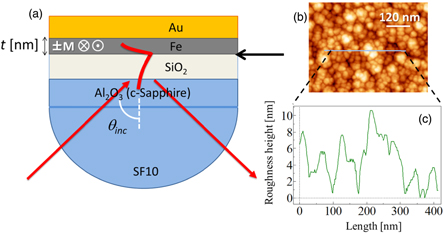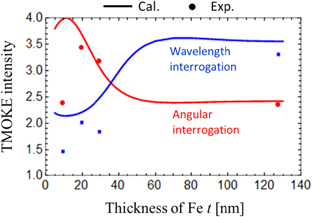マグネトプラズモニック二層誘電体構造における全反射減衰応答の鉄厚さ依存性:角度と波長の関係の解明
Fe thicknesses dependence of attenuated total reflection response in magnetoplasmonic double dielectric structures: angular versus wavelength interrogation
光センサは、テレビのリモコンやエアコンのスイッチ、自動ドアの開閉など身近な機器に使用されている技術である。光センサのうち、光アイソレータや光スイッチは磁界や電圧を入力として光信号を変調するデバイスである。高効率化することで、わずかな入力の変化で大きな出力信号変化を得ることができる。
一方で出力信号の変化を読み取ることで入力信号の変化(屈折率、磁界、電界)を高感度で検出することができる。表面プラズモンに磁気光学効果を通じて強磁性金属(=鉄)に磁気的な変調を加えた際に、表面プラズモン共鳴が起こる角度や波長の位置が変調されうる。

清水研究室で、二層誘導体構造と強磁性金属からなる表面プラズモン共鳴構造に含まれる鉄の厚さによって、変調されるものが異なることが発見された。
鉄が薄い場合、磁場により表面プラズモン共鳴が起こる角度が、厚い場合は波長と角度の位置の両方が変調されることが分かった。この発見から、金属に含まれる鉄の厚さによって、分析物の屈折率を検出するか、吸収係数を検出するかを変えられることが示唆された。

将来的に分析物の屈折率と吸収係数の両方を検知できる光センサが高感度化されることで、手のひらサイズの光集積回路やIoTセンサの実現が期待される。
Optical sensors are a technology that is used in familiar devices such as TV remote controls, air conditioner switches, and automatic door openers.
Among optical sensors, optical isolators and optical switches are devices that modulate optical signals using a magnetic field or voltage as input. By increasing the efficiency, it is possible to obtain a large change in the output signal with a small change in the input. On the other hand, changes in the input signal (refractive index, magnetic field, electric field) can be detected by reading the changes in the output signal.
When magnetic modulation is applied to ferromagnetic metal (= iron) through magneto-optical effect to surface plasmon, the angle and wavelength position can be modulated.
In Shimizu Lab, it was found that what is modulated depends on the thickness of the iron in the structure of the sensor. When the iron is thin, the angular position is modulated by the magnetic field, and when it is thick, both the wavelength and the angular position are modulated. This finding suggests that the mode of investigation (refractive index or absorption coefficient) changes depending on the thickness of the iron within the metal multilayer.
As optical sensors become more sensitive in the future, handy optical integrated circuits and IoT sensors are expected to be realized.
文責 Text by: N.S. (Graduate student)
Reference:
Kaihara, Terunori; Shimodaira, Takahiro; Suzuki, Shogo; Cebollada, Alfonso; Armelles, Gaspar; Shimizu, Hiromasa 清水 大雅, JAPANESE JOURNAL OF APPLIED PHYSICS (2019) Fe thicknesses dependence of attenuated total reflection response in magnetoplasmonic double dielectric structures: angular versus wavelength interrogation doi.org/10.7567/1347-4065/ab5205